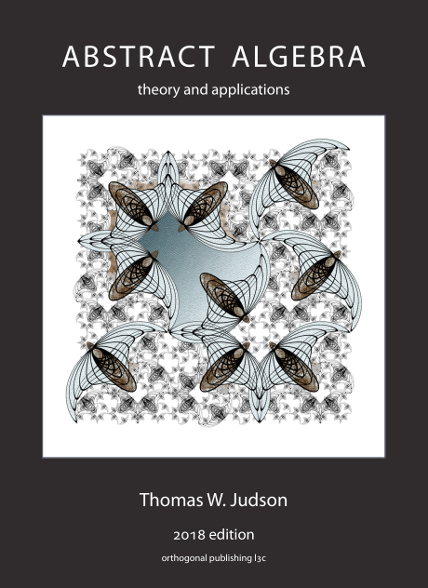Section 8.1 Symmetries
A symmetry of a geometric figure is a rearrangement of the figure preserving the arrangement of its sides and vertices as well as its distances and angles. A map from the plane to itself preserving the symmetry of an object is called a rigid motion. For example, if we look at the rectangle in Figure 8.1, it is easy to see that a rotation of \(180^{\circ}\) or \(360^{\circ}\) returns a rectangle in the plane with the same orientation as the original rectangle and the same relationship among the vertices. A reflection of the rectangle across either the vertical axis or the horizontal axis can also be seen to be a symmetry. However, a \(90^{\circ}\) rotation in either direction cannot be a symmetry unless the rectangle is a square.
Let us find the symmetries of the equilateral triangle \(\bigtriangleup ABC\text{.}\) To find a symmetry of \(\bigtriangleup ABC\text{,}\) we must first examine the permutations of the vertices \(A\text{,}\) \(B\text{,}\) and \(C\) and then ask if a permutation extends to a symmetry of the triangle. Recall that a permutation of a set \(S\) is a one-to-one and onto map \(\pi :S \rightarrow S\text{.}\) The three vertices have \(3! = 6\) permutations, so the triangle has at most six symmetries. To see that there are six permutations, observe there are three different possibilities for the first vertex, and two for the second, and the remaining vertex is determined by the placement of the first two. So we have \(3 \cdot 2 \cdot 1 = 3! = 6\) different arrangements. To denote the permutation of the vertices of an equilateral triangle that sends \(A\) to \(B\text{,}\) \(B\) to \(C\text{,}\) and \(C\) to \(A\text{,}\) we write the array
Notice that this particular permutation corresponds to the rigid motion of rotating the triangle by \(120^{\circ}\) in a clockwise direction. In fact, every permutation gives rise to a symmetry of the triangle. All of these symmetries are shown in Figure 8.2.
A natural question to ask is what happens if one motion of the triangle \(\bigtriangleup ABC\) is followed by another. Which symmetry is \(\mu_1 \rho_1\text{;}\) that is, what happens when we do the permutation \(\rho_1\) and then the permutation \(\mu_1\text{?}\) Remember that we are composing functions here. Although it is natural to read the multiplication operation from left to right, we compose functions right to left. We have
This is the same symmetry as \(\mu_2\text{.}\) Suppose we do these motions in the opposite order, \(\rho_1\) then \(\mu_1\text{.}\) It is easy to determine that this is the same as the symmetry \(\mu_3\text{;}\) hence, \(\rho_1 \mu_1 \neq \mu_1 \rho_1\text{.}\) A multiplication table for the symmetries of an equilateral triangle \(\bigtriangleup ABC\) is given in Table 8.3.
Notice that in the multiplication table for the symmetries of an equilateral triangle, for every motion of the triangle \(\alpha\) there is another motion \(\beta\) such that \(\alpha \beta = \identity\text{;}\) that is, for every motion there is another motion that takes the triangle back to its original orientation.
| \(\circ\) | \(\identity\) | \(\rho_1\) | \(\rho_2\) | \(\mu_1\) | \(\mu_2\) | \(\mu_3\) |
| \(\identity\) | \(\identity\) | \(\rho_1\) | \(\rho_2\) | \(\mu_1\) | \(\mu_2\) | \(\mu_3\) |
| \(\rho_1\) | \(\rho_1\) | \(\rho_2\) | \(\identity\) | \(\mu_3\) | \(\mu_1\) | \(\mu_2\) |
| \(\rho_2\) | \(\rho_2\) | \(\identity\) | \(\rho_1\) | \(\mu_2\) | \(\mu_3\) | \(\mu_1\) |
| \(\mu_1\) | \(\mu_1\) | \(\mu_2\) | \(\mu_3\) | \(\identity\) | \(\rho_1\) | \(\rho_2\) |
| \(\mu_2\) | \(\mu_2\) | \(\mu_3\) | \(\mu_1\) | \(\rho_2\) | \(\identity\) | \(\rho_1\) |
| \(\mu_3\) | \(\mu_3\) | \(\mu_1\) | \(\mu_2\) | \(\rho_1\) | \(\rho_2\) | \(\identity\) |
